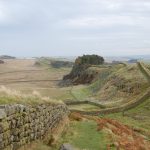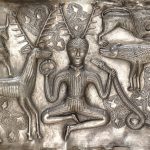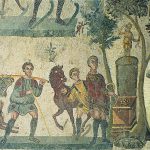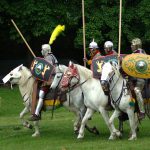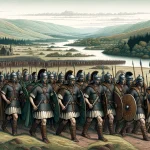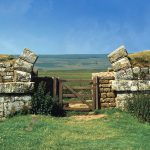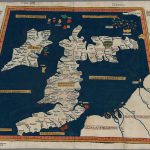Silchester (Calleva Attrebatum) Roman Settlement
Minor Settlement
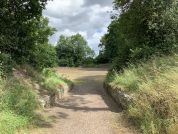
Calleva Atrebatum (“Calleva of the Atrebates”) was an Iron Age settlement, as capital of the Atrebates tribe. After the Roman conquest of AD 43 it became the large walled town in the Roman province of Britannia at a major crossroads in the Roman roads of Britain. Unlike most Roman towns, it was never reoccupied or built over after it was abandoned in the 6th or 7th century, so archaeological investigations have given an unusually complete picture of its development.
Its ruins lie to the west of, and partly beneath, the Church of St Mary the Virgin, Silchester, in Hampshire, England. The church occupies a site just within the ancient walls but the village of Silchester is about a mile (1.6 km) to the west.
Calleva Atrebatum / Calleva Atrebatvm –
“… then the Atrebati and their town Caleva 19*00 54°15 …”
Built originally of wood shortly after the Claudian invasion, the forum and basilica which stood at the centre of the civitas capital of the Atrebates tribe had been replaced in stone by the end of the second century. The town’s oval amphitheatre was built outside the town defences to the northeast sometime between 60AD and 85AD, thus making it one of the earliest in Britain. By the third century the town was defended by stone walls over 6.3 metres high, enclosing an area of 43 hectares. The third-century Roman settlement had the usual grid-like pattern of streets and possessed impressive monumentally-built forum, basilica, baths-complex and three temples, but contained only about 180 houses built in stone however, and large areas of the city, particularly the fringes, were of wooden construction.
At some time during the late-third century Calleva was razed to the ground by a catastrophic fire. This conflagration may have been the result of a hostile force sacking the city, but as already pointed out, the suburbs were largely made of wood and must have presented a fearful fire hazard; the city may have been destroyed by something as mundane as a stray spark from a cooking fire during a particularly hot summer. Despite the devastating fire the city was rebuilt and continued to flourish until perhaps the sixth century, after which it was abandoned.
The name Calleva is Welsh/Gaelic for ‘The Place in the Woods,’ and the Roman suffix Atrebatum meaning ‘of the Atrebates,’ designates it as the civitas or civil capital of the tribe.
Classical References to Calleva Attrebatum (Silchester)
Aside from the reference in Ptolemy quoted above, the only other classical geographical work to mention Silchester is the Antonine Itinerary of the late-second century. The dearth of references in other sources is more than compensated by this document which names Calleva in no less than four out of the fifteen British routes it describes. Three of these itinera name the town either as the starting or end point of the route, the itinerary terminus, which underlines the importance of the town in Roman times.
The town appears in the middle of Iter VII, entitled “The Route from [Noviomagus] Regnorum to Londinium“, which records the Roman road-stations between Chichester in Sussex, the capital city of the Regnenses tribe, and the provincial capital of Britannia, London (Londinium). The town is listed in the Seventh Itinerary 22 miles from Venta Belgarum (Winchester, Hampshire) the civitas capital of the Belgae, and 22 miles from Pontes (Staines, Surrey).
Silchester is the end terminus of Iter XIII “The Route from Isca [Silurum] to Calleva“, and Iter XIV “An Alternative Route from Isca [Silurum] to Calleva“, both of which start off from the fortress of the Second Augustan Legion at Caerleon in the county of Gwent in South Wales. The Thirteenth Itinerary takes the northern route of 109 miles through Gloucester, while the Fourteenth Itinerary takes a water-borne route of 103 miles across the Bristol Channel via Bath. Both itinera quote a distance of 15 miles from the penultimate station Spinis, which is unidentified but may lie near Newbury in Berkshire.
The last mention of Roman Silchester appears in Iter XV, this time as the starting point of a trade-route entitled “The Route from Calleva to Isca Dumnoniorum – one-hundred and thirty-six miles”. This itinerary linked Silchester to the civitas capital of the Dumnonii and former legionary base of the Second Augustan Legion at Exeter in Devon, and started off with a journey to Vindomis (Neatham, Hampshire), listed 15 miles distant.
Other “Concrete” Evidence
Many of the inscribed stones recovered from the environs of Roman Silchester have been defaced over the years and are no longer legible. Besides the texts presented below, the only other fragmentary inscriptions on stone worth talking about are RIB 76, the text of which reads … IN M … ATREBATVM … and makes mention “of the Atrebates”, also the milestone or honorific pillar RIB 2221, found 1¼ miles west of Silchester, which reads simply IMP or Imperator; again, not very helpful!
Roman Temples at Silchester
Romano-British Temples 1 & 2
This pair of square shrines lie within a temenos just inside the E gateway. Both temples faced east:
- Temple 1, situated to the north is the larger, its podium is raised about 7½ feet above the ground-level, its portico measures 73 feet square, the cella 42 feet square, all walls are 3 feet thick. This is the largest known Romano-British temple in Britain, covering an area of 5,329 square feet. Due to the relative thinness of the walls it is thought that the building was half-timbered, perhaps with a wooden stair to street-level. First built in the late-1st century, the masonry was later renewed, the building falling into disuse during the late-4th century. (Type Ib-e or IIb-e)
- Temple 2 to the south, on a lower podium than Temple 1, has outer walls only 2 feet thick enclosing a portico of about 50 feet square and a cella with 3 foot thick walls around 24 feet square. Built in the late-1st century and later having its plaster renewed, this building remained in use until the late-4th century. (Type Ib, or IIb)
Romano-British Temple 3
This square temple lies 100 yards south-east of the forum within the city. Its portico was defined by walls 1½ feet thick enclosing an area of 36½ feet by 35 feet, with a cella measuring 17¾ feet by 15¾ feet enclosed by more-substantial walls over 2¾ feet in thickness. Fragments of stone columns were found about 1½ feet in diameter, these may easily have stood 10½ feet high. This late-1st century temple faced east. (Type Ia, possibly IIa)
Decahexagonal Temple 4
A sixteen-sided polygonal temple lies in a temenos to the south of the forum. The outer portico, defined by walls just under 2½ feet thick, measured about 65 feet across, the cella was just over 40½ feet across, with slightly-thicker walls. The remains of several columns were found, around 1 ft. in diameter, they could have measured about 10 ft. high. Built during the 2nd century, the orientation of the temple is uncertain.
Apsidal Temple 5
This temple stood to the north-east of the forum in the south-east corner of Insula XXI. This squat, rectangular building with 3 ft. thick walls measures about 30½ ft. by 24½ ft., with its long axis aligned north-south and a semicircular apse projecting a further 7 ft. at its northern end. Egress was attained through two opposing doors set at the extreme southern ends of both the east and west sides. Its plan and prominent position suggest that it was a temple.
Possible Apsidal Temple 6
This possible shrine stood in the north-west angle of the insula-temenos by the east gate which contained Silchester Temples #1 & #2. This squat, apsidal building measures about 27 ft. by 27 ft. including a large semicircular apse which extended along its north-west side. The plan of the building, along with its prominent position within the sacred precinct, suggest that this too was a temple or shrine.
The Gods of Roman Silchester
RIB 67 - Dedication to Hercules Saego...
To the god Hercules Saegoṇ[], Titus Tammonius Vitalis, son of Saenius Tammonius, (set this up) on account of the honour [..
SAEGOṆ[..]
T TAMMON[...]
SAENI TAMMON[ ...]
VITALIS OB HONO[...]
[...]
Tammonius, see RIB 87 Tam(monius). It does not seem to be matched elsewhere. Addenda from RIB+add. (1995): Birley, Life in Roman Britain (1964), 68, notes that the dedicator’s nomen is derived from his father’s cognomen, which should thus be Tammo or Tammonus.
Another artifact of religious importance discovered in Silchester is a gold ring inscribed with the words “Senicianus, live in God” (CIL VII.1305), which is of obvious Christian significance.
RIB 68 - Dedication to Julia Augusta
… of Julia Augusta, mother of the senate and of the army, Marcus Sabinius Victor on account of [..
MATRI SE
NATVS ET
CASTROR
M SABINIVS
VICTOR OB
[...]
The dedication presumably began with a phrase like pro salute, and can hardly have failed to include the emperor with whose name Julia was associated. Julia was either Julia Domna associated with Caracalla (A.D. 212-17), or Julia Mamaea, associated with Severus Alexander (222-35). The noun governed by ob is not preserved.
The Civilian Settlement
The entire layout of the settlement within its polygonal defences were seen clearly for the first time on aerial photographs taken just after the Second World War in 1949 (JRS 1953 p.89).
There appear to have been a considerable number of foreign tradesmen and artisans living and working in Roman Silchester, as several large dedicatory slabs have been unearthed, all dedicated by members of the Guild (Collegium) of foreigners (Peregrini). The texts from three of these stones are shown and translated below.
Dedicatory Inscriptions by the Collegium Peregrinorum
- The word signum has a number of meanings, many of which may be relavent; ‘statue, image, picture, standard, signal, sign, token’, etc.
Often, the best source of information regarding the civilian population of a Roman town would be obtained from the tombstones of its former inhabitants. Unfortunately, there is only one legible tombstone recorded at Calleva the text of which is given below. It would appear that a relative of the deceased is mentioned on a dedication to the god Hercules (vide Rib 67 supra).
RIB 87 - Funerary inscription for Flavia Victorina
To the memory of Flavia Victorina Titus Tammonius Victor, her husband, set this up.
FL VICTORI
NAE T TAM
VICTOR
CONIVNX
POSVIT
For the nomen Tammonius see RIB 67.
A milestone was found 1¼ miles west of Silchester which reads, simply, IMP[eratori] “For the Emperor.” (RIB 2221). In addition to the Silchester stone, another milestone was found about 11 miles to the east of Calleva at Banisters near Turkdean, north-east of Berkhamstead in Berkshire (SU7863), just east of the crossing of the Londinium road over the Blackwater River. The Turkdean milestone reads, simply, FIL[ii] “… the son of …” (RIB 2315c; dated: 296-337AD?).
References for Calleva Atrebatvm
- The Towns of Roman Britain by John Wacher (2nd Ed., BCA, London, 1995) pp.271-291 & fig.123;
- Iron Age Communities in Britain by Barry Cunliffe (London 1974);
- The Romans in Britain – An Anthology of Inscriptions by A.R. Burn (Blackwell, Oxford, 1969);
- Temples in Roman Britain by M.J.T. Lewis (Cambridge 1966);
- The Roman Inscriptions of Britain by R.G. Collingwood and R.P. Wright (Oxford 1965).
- Air Reconnaissance of Southern Britain by J.K. St. Joseph in J.R.S. xliii (1953) pp.81-97;
Map References for Calleva Atrebatvm
NGRef: SU640625 OSMap: LR175
Roman Roads near Calleva Atrebatvm
N (21) to Dorchester On Thames (Oxfordshire) WNW (10) to Thatcham (Berkshire) E (27) to Pontes (Staines, Surrey) SSW (23) to Venta Belgarvm Iter XV: SSE (15) to Neatham SW (20) to East Anton (East Anton, Hampshire) Iter XIII: NW (12) to Spinae
Sites near Silchester (Calleva Attrebatum) Roman Settlement
- Port Way (1 km)
Roman Road - Thatcham (15 km)
Minor Settlement - Wickham Bushes Roman Settlement (23 km)
- Caesar's Camp (Bracknell Forest) (23 km)
Iron Age Hillfort - Neatham (Vindomis) Roman Settlement (23 km)
Antonine Posting Station and Minor Settlement - Weycock Hill Temple (24 km)
Temple Or Shrine - Tidbury Ring (26 km)
Iron Age Hillfort and Villa - Hambleden Roman Villa (27 km)
Villa - Andover (Leucomagus) Roman Settlement (30 km)
Minor Settlement - Dorchester on Thames (Dorcic) Roman Fort and Settlement (32 km)
Flavian Auxiliary Fort (AD 69–96), Pottery and Vicus
